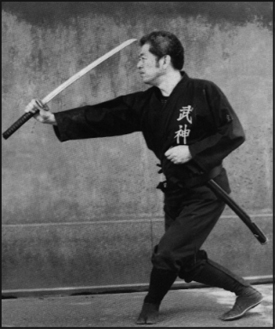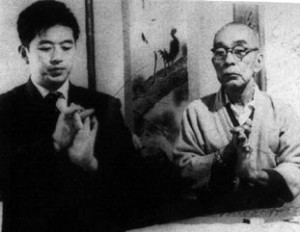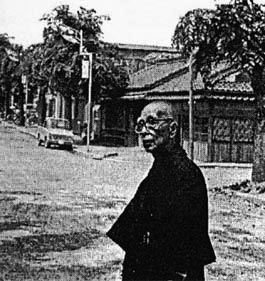Welcome!
Zanshin refers to a physical and mental state of heightened attention, particularly during and after combat situations. The Zanshinkai is the “abiding spirit” of three successful Sanshinkais that have taken place in Göttingen in the years 2013 – 2015. A big thank you to the many people and Bujinkan Dojos who have faithfully stood by and supported the Sanshinkai for three years!
The Sanshinkai was a large gathering (大会) in which we, three hearts (三 心), brought Japan content to Germany uncensored and we gave our best to convey more than technique. The contents and the weather in all three years were very different. Not because we have planned it this way, but because we were led by nature.
The end of March 2013 was marked by snow (雪). Duncan, Doug and I dyed our hair bleach blond. As Hatsumi Sensei announced the Ken / Tsurugi (剣) was the weapon of choice, that accompanied the year 2013 and which, therefore, was intensely used during the Sanshinkai. The Shindenfudo Ryu formed the basis of our Taijutsu and the term Kamiwaza also came up in 2013 for the first time.
The Sanshinkai at the end of March 2014 was marked by Spring (春). Sveneric, Doug and I taught with red cowboy hats, while the sun was shining and the cherry blossom was in full splendor. Shin Gin Budo (神韻 武 導) and thus more Kamiwaza was at the forefront of the substantive action. In order not to pull the rug out from under the participants feet, movements from the Togakure Ryu and techniques with Ninja Biken formed the basis on that weekend.
The time around and especially after the Sanshinkai at the end of March 2015 was quite stormy (嵐). Paul, Doug and I wore black hats with devil’s horns. The sky was often dark and it stormed so much that trees fell down and cars were thrown upside down next to the roads. The contents of the seminar were affected by profound concepts such as Sanshin Muto (三 心 無 刀) and Gokou Goshin (悟 光 護 心). By now Kamiwaza was part of our usual seminar atmosphere. The reference to the basis were movements from the Koto Ryu and the handling of the Nagamaki.
How can we learn to recognise the essence of our art, ie. the 9 traditions, which Hatsumi Sensei called Bujinkan in honor of Takamatsu Sensei? A martial art that has a name with direct reference to the war gods (Bujin) and that is based on movements which are difficult to detect with the human eye (Kamiwaza), can only be understood if true hearts (Shin) walk the path perseveringly (Nin).
3 x 3 people have gathered on the last weekends in March to run the Sanshinkai 2013 – 2015. A weekend where I could celebrate my birthday with friends/buyu on Friday (2013), then Saturday (2014) and finally Sunday (2015).
At the first Zanshinkai 2016 (2+0+1+6=9), 9 teachers (3 x 3) who walk Hatsumi Sensei’s path and embody the Bujinkan went out of their way with their great knowledge of just about 30 years each, together 270 years (2+7+0=9) Bujinkan experience, to inspire the participants (Sveneric Bogsäter, Paul Masse, Oliver Piskurek, Juan Manuel Serrano, Lauri Jokinen, Nikolaos Stefanidis, Stephan Zimmer, Pino Durante, Ercan Sarbat). Hatsumi Sensei spoke of Kujin Kasumi and Muto Dori. Subjects that we included in the training and mixed with a portion of basic Kukishindenryu movements, so there was something for every taste.
The second Zanshinkai 2017 was marked by a great teaching team of 6 (Doug Wilson, Oliver Piskurek, Sheila Haddad, Arnaud Cousergue, Lauri Jokinen and Ralph Schwager). Bujinkan contents such as the Muto Dori and Kannin Dokuson were discussed by Hatsumi Sensei and addressed by the instructors in the Taijutsu with and without weapons. The teamwork was great and the atmosphere was challenging, but was brought back to the ground with a base of Takagiyoshin Ryu and other content for all participants.
For the third Zanshinkai 2018, we again had a first-class team of 6 teachers that gathered in Göttingen (Sveneric Bogsäter, Doug Wilson, Oliver Piskurek, Luboš Pokorný, Kostas Kanakis, Christian Petroccello), supported by our special friend from the USA (Sheila Haddad), to teach Bujinkan material in line with content in Japan, such as Muto Dori and Mon Jyu Ji Shin.
We celebrated our six year tradition with gold medals for all teachers.
Our new concept started in the year 2019 and combined our knowledge from the three Sanshinkai years and the three Zanshinkai years. Thus, we had our first new SZanshinkai in 2019. While the OLD-team (Oliver Piskurek, Lauri Jokinen, and Doug Wilson) was the heart of the event, we were happy to see our highly ranked Zanshinkai friends to present their skills on the tatami as well (Pino Durante, Jasper Juhl Holm, Zoran Radakovic, Mirek Čermák, Raik John, Sebastian Haasch). Muto Dori was still the focus of Hatsumi Senseis teachings with special reference to the nature of Marishiten known as the god/goddess of the warrior class.
In the year 2020, we’ll present three main teachers – Thomas Franzén, Oliver Piskurek und Kostas Kanakis – under direct influence by Hatsumi Sensei – which is strongly connected in transmitting the evolution of the Bujinkan. It is the first year in which Hatsumi Sensei withdraw himself from activ training and hands over the big responsibility to us to guide the Bujinkan to the future. This year, the year of the metal rat, starts with a well known topic which is also very relevant in this time, and it’s written with three letters only: NIN (忍)!
In 2021, we’ll present Michael Schjerling, Oliver Piskurek, and Marco Borst, three Bujinkan bedrocks in Europe, in the year of the metal-ox. Difficult times require people who live NIN and keep going whatever happens. Covid is just a moment in time and will not stop us to inspire people to follow Hatsumi Senseis way. Keep going is the message.
The year of the water tiger 2022 marks the end of our three-year-concept with three main teachers and six guest teachers. Thus, we drained the Szanshinkai this year and Oliver Piskurek, together with six guests, gave a smaller event to get ready for next year in which we change the program again. Nevertheless, we had great fun and continued with a NIN mindset in the last Covid year.
Back to the roots in 2023, during the SanshinTaikai in the year of the water rabbit, we’ll present Duncan Stewart, Oliver Piskurek, and Doug Wilson, like 10 years ago when we started!
We are looking forward to seeing you at this great meeting!
鷲 龍Welcome!
Zanshin refers to a physical and mental state of heightened attention, particularly during and after combat situations. The Zanshinkai is the “abiding spirit” of three successful Sanshinkais that have taken place in Göttingen in the years 2013 – 2015. A big thank you to the many people and Bujinkan Dojos who have faithfully stood by and supported the Sanshinkai for three years!
The Sanshinkai was a large gathering (大会) in which we, three hearts (三 心), brought Japan content to Germany uncensored and we gave our best to convey more than technique. The contents and the weather in all three years were very different. Not because we have planned it this way, but because we were led by nature.
The end of March 2013 was marked by snow (雪). Duncan, Doug and I dyed our hair bleach blond. As Hatsumi Sensei announced the Ken / Tsurugi (剣) was the weapon of choice, that accompanied the year 2013 and which, therefore, was intensely used during the Sanshinkai. The Shindenfudo Ryu formed the basis of our Taijutsu and the term Kamiwaza also came up in 2013 for the first time.
The Sanshinkai at the end of March 2014 was marked by Spring (春). Sveneric, Doug and I taught with red cowboy hats, while the sun was shining and the cherry blossom was in full splendor. Shin Gin Budo (神韻 武 導) and thus more Kamiwaza was at the forefront of the substantive action. In order not to pull the rug out from under the participants feet, movements from the Togakure Ryu and techniques with Ninja Biken formed the basis on that weekend.
The time around and especially after the Sanshinkai at the end of March 2015 was quite stormy (嵐). Paul, Doug and I wore black hats with devil’s horns. The sky was often dark and it stormed so much that trees fell down and cars were thrown upside down next to the roads. The contents of the seminar were affected by profound concepts such as Sanshin Muto (三 心 無 刀) and Gokou Goshin (悟 光 護 心). By now Kamiwaza was part of our usual seminar atmosphere. The reference to the basis were movements from the Koto Ryu and the handling of the Nagamaki.
How can we learn to recognise the essence of our art, ie. the 9 traditions, which Hatsumi Sensei called Bujinkan in honor of Takamatsu Sensei? A martial art that has a name with direct reference to the war gods (Bujin) and that is based on movements which are difficult to detect with the human eye (Kamiwaza), can only be understood if true hearts (Shin) walk the path perseveringly (Nin).
3 x 3 people have gathered on the last weekends in March to run the Sanshinkai 2013 – 2015. A weekend where I could celebrate my birthday with friends/buyu on Friday (2013), then Saturday (2014) and finally Sunday (2015).
At the first Zanshinkai 2016 (2+0+1+6=9), 9 teachers (3 x 3) who walk Hatsumi Sensei’s path and embody the Bujinkan went out of their way with their great knowledge of just about 30 years each, together 270 years (2+7+0=9) Bujinkan experience, to inspire the participants (Sveneric Bogsäter, Paul Masse, Oliver Piskurek, Juan Manuel Serrano, Lauri Jokinen, Nikolaos Stefanidis, Stephan Zimmer, Pino Durante, Ercan Sarbat). Hatsumi Sensei spoke of Kujin Kasumi and Muto Dori. Subjects that we included in the training and mixed with a portion of basic Kukishindenryu movements, so there was something for every taste.
The second Zanshinkai 2017 was marked by a great teaching team of 6 (Doug Wilson, Oliver Piskurek, Sheila Haddad, Arnaud Cousergue, Lauri Jokinen and Ralph Schwager). Bujinkan contents such as the Muto Dori and Kannin Dokuson were discussed by Hatsumi Sensei and addressed by the instructors in the Taijutsu with and without weapons. The teamwork was great and the atmosphere was challenging, but was brought back to the ground with a base of Takagiyoshin Ryu and other content for all participants.
For the third Zanshinkai 2018, we again had a first-class team of 6 teachers that gathered in Göttingen (Sveneric Bogsäter, Doug Wilson, Oliver Piskurek, Luboš Pokorný, Kostas Kanakis, Christian Petroccello), supported by our special friend from the USA (Sheila Haddad), to teach Bujinkan material in line with content in Japan, such as Muto Dori and Mon Jyu Ji Shin.
We celebrated our six year tradition with gold medals for all teachers.
Our new concept started in the year 2019 and combined our knowledge from the three Sanshinkai years and the three Zanshinkai years. Thus, we had our first new SZanshinkai in 2019. While the OLD-team (Oliver Piskurek, Lauri Jokinen, and Doug Wilson) was the heart of the event, we were happy to see our highly ranked Zanshinkai friends to present their skills on the tatami as well (Pino Durante, Jasper Juhl Holm, Zoran Radakovic, Mirek Čermák, Raik John, Sebastian Haasch). Muto Dori was still the focus of Hatsumi Senseis teachings with special reference to the nature of Marishiten known as the god/goddess of the warrior class.
In the year 2020, we’ll present three main teachers – Thomas Franzén, Oliver Piskurek und Kostas Kanakis – under direct influence by Hatsumi Sensei – which is strongly connected in transmitting the evolution of the Bujinkan. It is the first year in which Hatsumi Sensei withdraw himself from activ training and hands over the big responsibility to us to guide the Bujinkan to the future. This year, the year of the metal rat, starts with a well known topic which is also very relevant in this time, and it’s written with three letters only: NIN (忍)!
In 2021, we’ll present Michael Schjerling, Oliver Piskurek, and Marco Borst, three Bujinkan bedrocks in Europe, in the year of the metal-ox. Difficult times require people who live NIN and keep going whatever happens. Covid is just a moment in time and will not stop us to inspire people to follow Hatsumi Senseis way. Keep going is the message.
The year of the water tiger 2022 marks the end of our three-year-concept with three main teachers and six guest teachers. Thus, we drained the Szanshinkai this year and Oliver Piskurek, together with six guests, gave a smaller event to get ready for next year in which we change the program again. Nevertheless, we had great fun and continued with a NIN mindset in the last Covid year.
Back to the roots in 2023, during the SanshinTaikai in the year of the water rabbit, we’ll present Duncan Stewart, Oliver Piskurek, and Doug Wilson, like 10 years ago when we started!
We are looking forward to seeing you at this great meeting!
鷲 龍


 Deutsch
Deutsch

